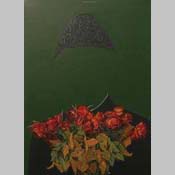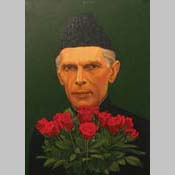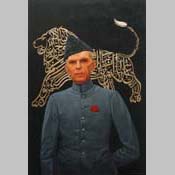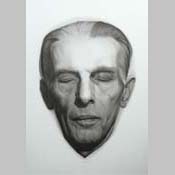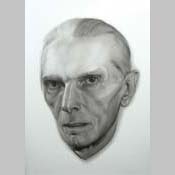As Pakistanis, we are all used to seeing Quaid-e Azam’s portrait on currency notes. These commemorative pictures honour his services towards Pakistan and inseminate national pride and unity among people. Quaid’s portrait is also displayed at a prominent location in all government offices. This is an unwritten rule or sometimes with written orders (referring to the recent scandalous incident at WAPDA where the chairman wanted to replace it with his own). Following this trend, the legislative houses and other state offices have portrait galleries to house the collection of Jinnah’s portraits that they have generously commissioned over the period in remembrance of his considerate efforts to create a safe haven for the Muslims of the Subcontinent. It will not be an exaggeration that in such paintings Jinnah is portrayed as an absolute embodiment of the Pakistani State. Though this imagery and symbolism pertinent to Jinnah remain unblemished across several successive democratic and military regimes, the mechanization in terms of his attire exhibits peculiar interest of the ones in power. President Ayub Khan propagated Jinnah with cap for official representation which he too embraced to launch himself as a legitimate heir to the founder’s legacy. During the ‘80s Jinnah appeared in sherwani to match the “Islamic” outlook as envisioned by the then rulers. 20th century’s “moderate enlightenment” swathed Quaid in a Western three-piece suit with a pipe in his mouth and dogs by his side –a typical personification of enlightenment (Don’t miss the satirical punk). This often-changing portrayal of Jinnah is a notable strain in the misstated national history.
Keeping all such political schemata aside that can be traced back to the 1957 impugnation on printing Quaid’s portrait on currency notes initiated by religious and political parties and supported by businessmen, artists have always painted Quaid’s portraits with much patriotic fervor. Its been considered a matter of great honour to get a chance to paint the father of the nation. Many artists have successfully captured the elegance, style and stature of one of the greatest leaders and statesmen of modern politics. In a recent show titled Haq to yeh ha ke Haq ada na hoa, artist Ali Azmat changed the perception of Quaid forever. Instead of a composed, calm and content politician watching over his nation from the gilded frames, Azmat has painted a portrait of a man named Muhammad Ali Jinnah. He portrays the subject over and over again, 29 times for this particular show. One wonders if it's Azmat’s dedication, passion or obsession. He doesn’t seem to get enough of Jinnah. The varying size of his surfaces (paper and canvas), contrasting mediums (oil, acrylic ,graphite and crayon) and changing expressions on the face of Quaid denote as if he is in dialogue with the artist.
What does Azmat have to say to the Quaid? What was Quaid’s response? Is Azmat talking to the father on the nation’s behalf or is it a private conversation? Does the founder know what’s happening to his country? Is he angry, disappointed or satisfied and hopeful? One has all these thoughts as one moves from one frame to another admiring the skill of the artist and his courage to take things up with none other than the leader, the father, the messiah, the visionary and the achiever of the impossible. The answers to these questions lie within one’s own self. One has to look inward to translate the expressions that Azmat has captured on Quaid’s face. At times, the sturdy, mature man is affectionate as if he is patiently watching us all as a nation to understand his vision, to acknowledge his sacrifices, to mend our ways, to enjoy being free, to prove our worth and to live exemplary lives. On other times, he sits as a confident , authoritative man showing his strength and signifying hope. Oh, then he deliberately leaves the frame –may be a wake-up call for us. Such is the intensity of the artworks that adorned the gallery walls.
For those who are not familiar with Azmat’s art practice, these up-close, larger-than-life portraits are his signature style. If you believe that eyes are the windows of the soul, then you will instantly get acquainted with his sitters at first glance. Recognized as a figural painter Azmat has more recently, opted to experiment with just the human form itself rather than composing it within a picture frame with supporting paraphernalia. His mastery lies in capturing the sentiments of his subjects and projecting them onto the viewer creating awe and inspiration at the same time. It is this adept technique when employed with devotion results in the exemplary show which has a very straightforward, apt title borrowed from Ghalib Haq to yeh ha ke Haq ada na hoa –The Reality is that the right/claim didn’t get fulfilled. The timing of the show is also much relevant which enhances its impact and overall reception. The credit goes to the curators. Dr Rahat Naveed Masud and Amna Ismail Patuadi had been in conversation with the artist and decided to bring it out on the Independence Day. As Quaid’s country goes through complicated times and the nation stands divided over unnecessary and insignificant issues such endeavors can bring about the much-needed coherence and stability in the society. Azmat is aware of this fact. He believes that “the affection displayed in these paintings not only expresses my love for our leader but also serves as a humble effort to keep this love alive in the hearts of future generations”. One’s heart fills with joy and eyes with tears when one finds young kids sitting in PNCA gallery copying Azmat’s artworks or posing in front of them with small flags and slogans of Quaid-e Azam zindabad, Pakistan paindabad.
The curators are adamant about promoting this national solidarity and awareness about the power of art to change the course of action in today’s a Pakistan. The exhibition endorses the need to align Pakistan according to Quaid’s vision. Both, Masud and Pataudi come from the families who have significantly contributed in Pakistani politics since pre-partition. They themselves have served the motherland as educators and artists. This exhibition is a little tribute to the country they love and to the people they care about. They aim to make it a traveling exhibition around the country. It has already visited Lahore, Islamabad and Gilgit.
The writer is a Lahore-based academic & a published scholar with a focus on decolonizing art history for a global audience.
CAPTION
36 x 24 inches, acrylics on canvas19 x 26 inches, acrylics on canvas
60 x 42 inches, compressed charcoal on sheet
19 x 26 inches, acrylics on canvas
60 x 42 inches, compressed charcoal on sheet


